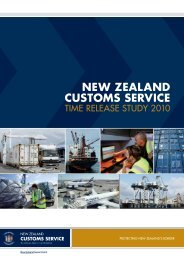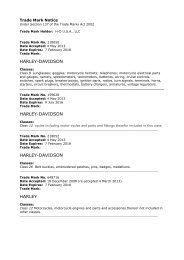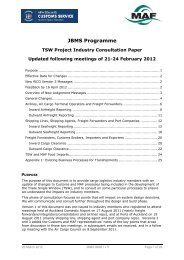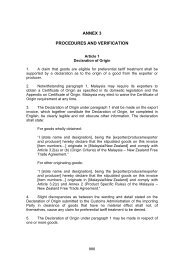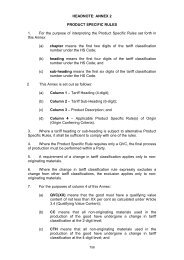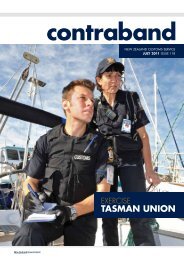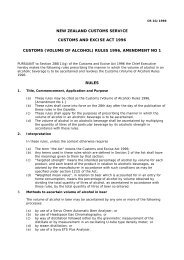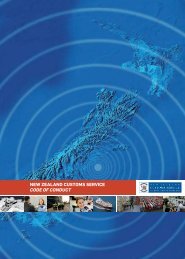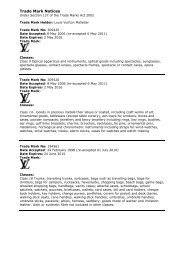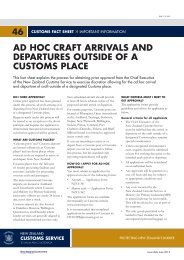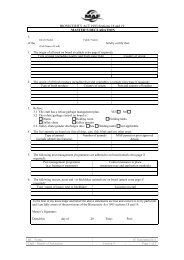Fact Sheet 24 - Controls on the importation of hazardous substances
Fact Sheet 24 - Controls on the importation of hazardous substances
Fact Sheet 24 - Controls on the importation of hazardous substances
You also want an ePaper? Increase the reach of your titles
YUMPU automatically turns print PDFs into web optimized ePapers that Google loves.
ISSN 1175-396X<str<strong>on</strong>g>24</str<strong>on</strong>g>CUSTOMS FACT SHEET » IMPORTANT INFORMATIONCONTROLS ON THE IMPORTATIONOF HAZARDOUS SUBSTANCESThe Hazardous Substances and New Organisms (HSNO) Act 1996 places c<strong>on</strong>trols <strong>on</strong> <strong>the</strong>importati<strong>on</strong> <strong>of</strong> <strong>hazardous</strong> <strong>substances</strong>.WHAT IS A HAZARDOUSSUBSTANCE?A <strong>hazardous</strong> substance means anysubstance that has <strong>on</strong>e or more <strong>of</strong> <strong>the</strong>following <strong>hazardous</strong> properties:» Explosiveness (eg, fireworks)» Flammability (eg, fuels, solvents)» A capacity to oxidise (eg, peroxides,hypochlorites)» Corrosiveness (eg, acids, amm<strong>on</strong>ia)» Toxicity (eg, pesticides, someindustrial chemicals)» Ecotoxicity (eg, pesticides, chemicals,oils).WHAT ITEMS ARE COVERED BY THEHSNO ACT?Hazardous <strong>substances</strong>, as definedabove, are covered by <strong>the</strong> HSNO Act.These include pure chemicals as well asproducts such as glues, paints, pesticides,and so <strong>on</strong>, regardless <strong>of</strong> how <strong>the</strong>y arepackaged or presented.In additi<strong>on</strong>, manufactured articlesthat include or incorporate any kind<strong>of</strong> explosive substance are c<strong>on</strong>sidered‘<strong>hazardous</strong> <strong>substances</strong>’ and thus coveredby <strong>the</strong> HSNO Act.WHAT ITEMS ARE NOT COVERED BYTHE HSNO ACT?The following types <strong>of</strong> <strong>substances</strong>/products are NOT covered under <strong>the</strong>HSNO Act, ie, a HSNO approval is notrequired for <strong>the</strong>ir importati<strong>on</strong>:» Manufactured articles, eg, cars,electr<strong>on</strong>ic equipment, and machinery,even though those products c<strong>on</strong>tain<strong>hazardous</strong> <strong>substances</strong>. For examplea machine c<strong>on</strong>taining a lubricant isnot covered under HSNO, but if<strong>the</strong> lubricant were independentlyimported, it would require a HSNOapproval.» Substances that have <strong>hazardous</strong>properties below <strong>the</strong> prescribedthreshold levels. These thresholdlevels are set by legislati<strong>on</strong>,specifically <strong>the</strong> HazardousSubstances (Minimum Degrees <strong>of</strong>Hazard) Regulati<strong>on</strong>s 2001.» Food in a ready-to-eat form.» Finished form (human) medicines.» Infectious <strong>substances</strong>.» Radioactive <strong>substances</strong>.The obligati<strong>on</strong> is <strong>on</strong> importers toestablish whe<strong>the</strong>r <strong>the</strong> substance <strong>the</strong>yare importing falls within <strong>the</strong> scope <strong>of</strong><strong>the</strong> HSNO Act. If you are in any doubtabout whe<strong>the</strong>r <strong>the</strong> substance requires aHSNO approval, you should c<strong>on</strong>tact:Envir<strong>on</strong>mental Protecti<strong>on</strong> Authority(EPA)Teleph<strong>on</strong>e: 0800 376234Email: hsinfo@epa.govt.nzWebsite: www.epa.govt.nzIMPORTATION OF HAZARDOUSSUBSTANCES INTO NEW ZEALANDIf you wish to import a <strong>hazardous</strong>substance into New Zealand, it musthave a HSNO approval. The EPARegister c<strong>on</strong>tains a list <strong>of</strong> HSNOapprovals for all <strong>substances</strong> (singlecomp<strong>on</strong>ents, formulated products andGroup Standard Approvals).If <strong>the</strong> substance you wish to importdoes not have an existing HSNOapproval, you must obtain an approvalfrom <strong>the</strong> EPA prior to importing <strong>the</strong>substance. The approval number shouldbe able to be provided to Customs or anenforcement agency if requested.If you require advice <strong>on</strong> <strong>the</strong> HSNOstatus <strong>of</strong> <strong>the</strong> substance you areimporting, you should c<strong>on</strong>tact <strong>the</strong> EPA.AsbestosPlease note that raw asbestos does notcurrently have a HSNO approval. Assuch, it is not allowed to be importedinto New Zealand. If you wish toimport raw asbestos into New Zealand,you will need to make an applicati<strong>on</strong> to<strong>the</strong> EPA. Please c<strong>on</strong>tact <strong>the</strong> EPA foradvice <strong>on</strong> this process.Issue date March 2012
CUSTOMS FACT SHEET <str<strong>on</strong>g>24</str<strong>on</strong>g>ADDITIONAL REQUIREMENTS FORCERTAIN HAZARDOUS SUBSTANCES— IMPORT PERMITSImport permits are required for <strong>the</strong>following <strong>hazardous</strong> <strong>substances</strong>:» Explosives, including fireworks.These import certificates are issuedby <strong>the</strong> EPA and must be presentedto Customs.» Polychlorinated biphenyls (PCBs)and children’s cray<strong>on</strong>s and finger andwatercolour paints. These permitsare issued by <strong>the</strong> Ministry <strong>of</strong> Healthunder delegated authority from<strong>the</strong> EPA. The code MOH and <strong>the</strong>permit number must be entered in<strong>the</strong> Permit Informati<strong>on</strong> field <strong>on</strong> <strong>the</strong>Customs import entry.» Persistent organic pollutants(POPs) covered by <strong>the</strong> StockholmC<strong>on</strong>venti<strong>on</strong>, eg, aldrin, chlordane,dieldrin, polychlorinated biphenyls(PCBs). Any<strong>on</strong>e wishing to importa POP covered by <strong>the</strong> StockholmC<strong>on</strong>venti<strong>on</strong> must obtain priorapproval from <strong>the</strong> EPA. Thisincludes laboratories using <strong>the</strong>se<strong>substances</strong> as analytical standards.The approval to import must bepresented to Customs.ARE THERE LABELLINGREQUIREMENTS FOR HAZARDOUSSUBSTANCES?Importers <strong>of</strong> <strong>hazardous</strong> <strong>substances</strong>should ensure that <strong>the</strong>ir goods areclearly identified in accordance withinternati<strong>on</strong>al transportati<strong>on</strong> standardsso that <strong>the</strong> identity <strong>of</strong> <strong>the</strong> goods and<strong>the</strong>ir <strong>hazardous</strong> characteristics can bereadily distinguished. Clear identificati<strong>on</strong>will also assist with <strong>the</strong> handling andtreatment <strong>of</strong> <strong>the</strong> goods.WHAT HAPPENS IF I IMPORT AHAZARDOUS SUBSTANCE WITHOUTAPPROVAL?Hazardous <strong>substances</strong> that are importedwithout a HSNO approval are liable forseizure under <strong>the</strong> Customs and ExciseAct 1996. Importers should ensure thatan approval is obtained from <strong>the</strong> EPAprior to importing <strong>the</strong> goods intoNew Zealand.Similarly, <strong>substances</strong> that are importedinto New Zealand without <strong>the</strong> requiredimport permits as described above maybe seized. There is provisi<strong>on</strong> in <strong>the</strong>HSNO Act for <strong>the</strong> goods to be reexportedat cost to <strong>the</strong> importer.FURTHER INFORMATIONThe EPA has prepared a number <strong>of</strong>publicati<strong>on</strong>s that you may find to beparticularly relevant:» Informati<strong>on</strong> <str<strong>on</strong>g>Sheet</str<strong>on</strong>g> No. 16: Substancesthat may be <strong>hazardous</strong> under <strong>the</strong> HSNOAct 1996: A Guide for Importers andCustoms Brokers.» Informati<strong>on</strong> <str<strong>on</strong>g>Sheet</str<strong>on</strong>g> No. 14: Determining<strong>the</strong> status <strong>of</strong> a substance – do I need to getan approval?» Informati<strong>on</strong> <str<strong>on</strong>g>Sheet</str<strong>on</strong>g> No. 11: ManufacturedArticles.» User Guide to thresholds andclassifi cati<strong>on</strong>s (both as a summaryguide and a full guide).» Assigning a Substance to a GroupStandard» User Guide to Making a HazardousSubstance Applicati<strong>on</strong>.These publicati<strong>on</strong>s are available atwww.epa.govt.nz.FOR FURTHER INFORMATIONC<strong>on</strong>tact your nearest <strong>of</strong>fice <strong>of</strong> <strong>the</strong>New Zealand Customs Service, visit <strong>the</strong>Customs website www.customs.govt.nzor call Customs <strong>on</strong> 0800 428 786(0800 4 CUSTOMS).2 <str<strong>on</strong>g>C<strong>on</strong>trols</str<strong>on</strong>g> <strong>on</strong> <strong>the</strong> Importati<strong>on</strong> <strong>of</strong> Hazardous Substances
Issue date March 2012 3
CUSTOMS FACT SHEET <str<strong>on</strong>g>24</str<strong>on</strong>g>Office <strong>of</strong> <strong>the</strong> Comptroller <strong>of</strong> Customs, PO Box 2218, Wellingt<strong>on</strong>Ph<strong>on</strong>e: +64 4 901 4500 » Fax: +64 4 901 4555 » www.customs.govt.nzISSN 1175-396X4 <str<strong>on</strong>g>C<strong>on</strong>trols</str<strong>on</strong>g> <strong>on</strong> <strong>the</strong> Importati<strong>on</strong> <strong>of</strong> Hazardous Substances




